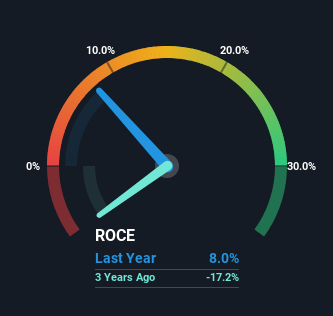Stock Analysis
- United States
- /
- Entertainment
- /
- NasdaqGS:SEAT
Returns Are Gaining Momentum At Vivid Seats (NASDAQ:SEAT)

What trends should we look for it we want to identify stocks that can multiply in value over the long term? Ideally, a business will show two trends; firstly a growing return on capital employed (ROCE) and secondly, an increasing amount of capital employed. This shows us that it's a compounding machine, able to continually reinvest its earnings back into the business and generate higher returns. So when we looked at Vivid Seats (NASDAQ:SEAT) and its trend of ROCE, we really liked what we saw.
Return On Capital Employed (ROCE): What Is It?
If you haven't worked with ROCE before, it measures the 'return' (pre-tax profit) a company generates from capital employed in its business. The formula for this calculation on Vivid Seats is:
Return on Capital Employed = Earnings Before Interest and Tax (EBIT) ÷ (Total Assets - Current Liabilities)
0.08 = US$85m ÷ (US$1.6b - US$488m) (Based on the trailing twelve months to December 2023).
So, Vivid Seats has an ROCE of 8.0%. In absolute terms, that's a low return and it also under-performs the Entertainment industry average of 11%.
View our latest analysis for Vivid Seats

In the above chart we have measured Vivid Seats' prior ROCE against its prior performance, but the future is arguably more important. If you're interested, you can view the analysts predictions in our free analyst report for Vivid Seats .
What The Trend Of ROCE Can Tell Us
Like most people, we're pleased that Vivid Seats is now generating some pretax earnings. Historically the company was generating losses but as we can see from the latest figures referenced above, they're now earning 8.0% on their capital employed. At first glance, it seems the business is getting more proficient at generating returns, because over the same period, the amount of capital employed has reduced by 20%. Vivid Seats could be selling under-performing assets since the ROCE is improving.
For the record though, there was a noticeable increase in the company's current liabilities over the period, so we would attribute some of the ROCE growth to that. The current liabilities has increased to 31% of total assets, so the business is now more funded by the likes of its suppliers or short-term creditors. It's worth keeping an eye on this because as the percentage of current liabilities to total assets increases, some aspects of risk also increase.
In Conclusion...
In summary, it's great to see that Vivid Seats has been able to turn things around and earn higher returns on lower amounts of capital. Astute investors may have an opportunity here because the stock has declined 43% in the last three years. So researching this company further and determining whether or not these trends will continue seems justified.
Like most companies, Vivid Seats does come with some risks, and we've found 1 warning sign that you should be aware of.
While Vivid Seats may not currently earn the highest returns, we've compiled a list of companies that currently earn more than 25% return on equity. Check out this free list here.
Valuation is complex, but we're helping make it simple.
Find out whether Vivid Seats is potentially over or undervalued by checking out our comprehensive analysis, which includes fair value estimates, risks and warnings, dividends, insider transactions and financial health.
View the Free AnalysisHave feedback on this article? Concerned about the content? Get in touch with us directly. Alternatively, email editorial-team (at) simplywallst.com.
This article by Simply Wall St is general in nature. We provide commentary based on historical data and analyst forecasts only using an unbiased methodology and our articles are not intended to be financial advice. It does not constitute a recommendation to buy or sell any stock, and does not take account of your objectives, or your financial situation. We aim to bring you long-term focused analysis driven by fundamental data. Note that our analysis may not factor in the latest price-sensitive company announcements or qualitative material. Simply Wall St has no position in any stocks mentioned.

Simply Wall St
About NasdaqGS:SEAT
Vivid Seats
Vivid Seats Inc. operates an online ticket marketplace in the United States, Canada, and Japan.
Undervalued with solid track record.
